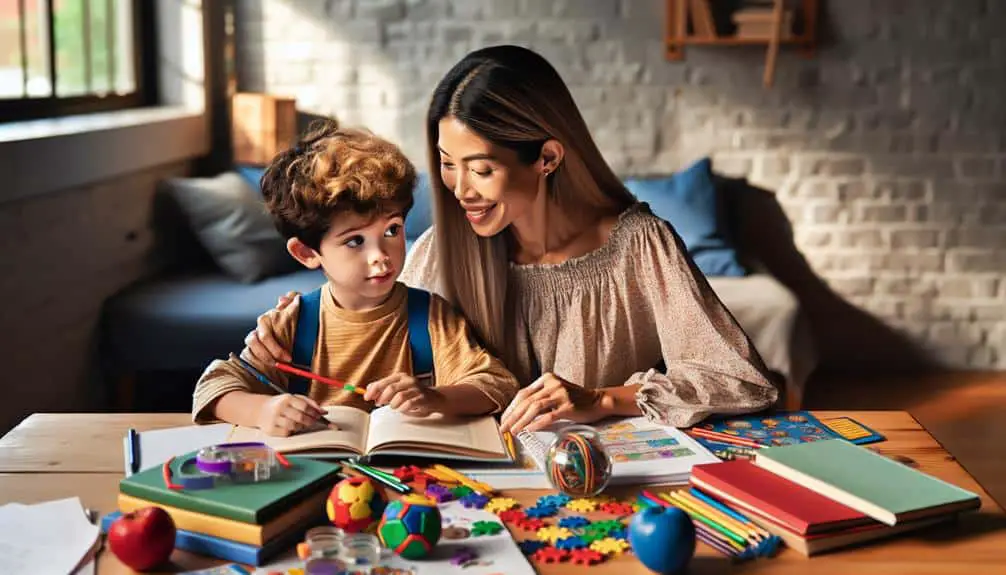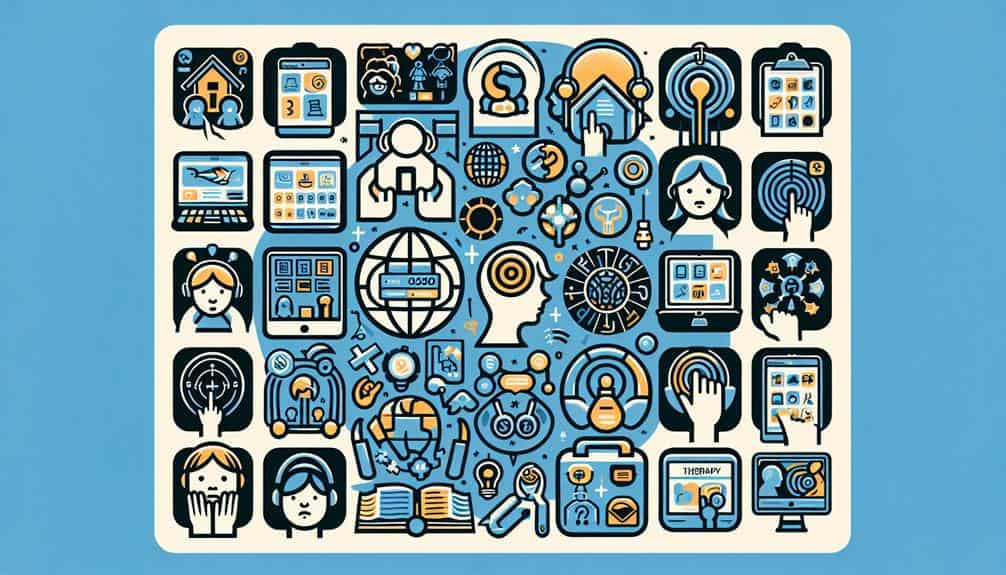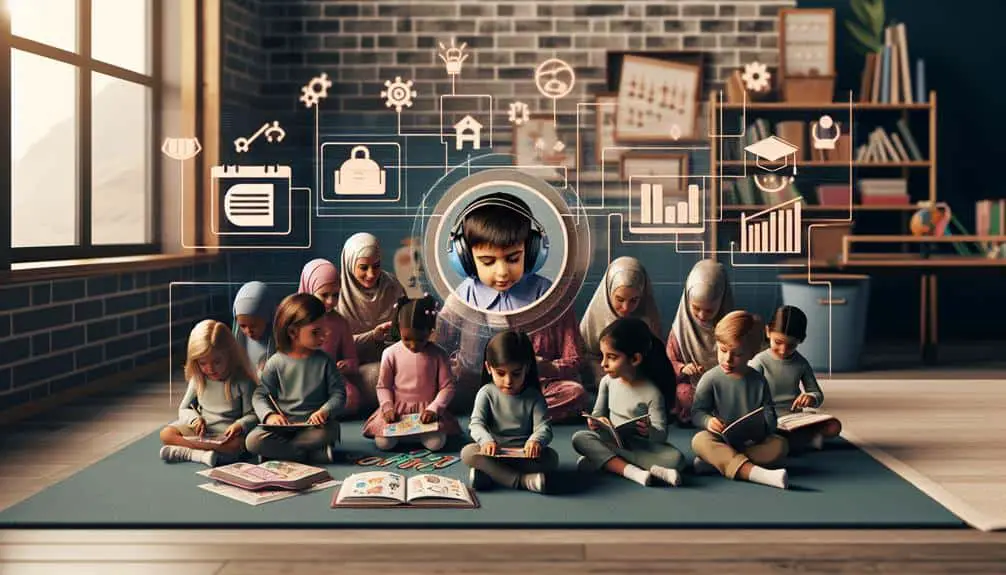Supporting your child with learning disabilities at home involves creating a tailored approach. Understand their unique challenges and implement personalized strategies for growth. Utilize individualized lesson plans and adaptive teaching methods for a more inclusive environment. Assistive technology like reading apps and math manipulatives can enhance their learning. Seek support from online communities for emotional backing and practical advice. Actively engage in IEP meetings, collaborate with teachers, and tailor plans to your child's needs. Regularly monitor progress, address concerns, and adjust strategies when needed. Take steps to support their academic and personal development further.
Key Points
- Create a structured routine to provide consistency and predictability.
- Use visual aids and organizational tools to enhance understanding.
- Offer positive reinforcement and encouragement for small achievements.
- Break tasks into smaller steps to avoid overwhelming the child.
- Foster a supportive and loving environment to boost confidence and self-esteem.
Understanding Different Learning Disabilities
Understanding the different types of learning disabilities can provide valuable insight into how to support children who may be facing challenges in their academic journey. Early intervention plays an essential role in helping children with learning disabilities. Identifying these challenges early on allows for specialized support through special education programs tailored to meet individual needs.
Cognitive processing difficulties can manifest in various ways, impacting a child's ability to comprehend information, solve problems, or retain knowledge. Special education services offer strategies to address these cognitive challenges, such as using multisensory approaches to enhance learning experiences.
Additionally, behavioral challenges often accompany learning disabilities, requiring a holistic approach that integrates behavioral interventions with academic support.
Tailored Curriculum Development Strategies
You can support children with learning disabilities by implementing individualized lesson plans and adaptive teaching methods.
By tailoring the curriculum to meet each child's unique learning needs, you can create a more inclusive and supportive educational environment.
These strategies can help children with learning disabilities thrive and reach their full potential in the classroom.
Individualized Lesson Plans
Crafting individualized lesson plans is an essential element in supporting children with learning disabilities, as it allows educators to tailor curriculum development strategies to meet each student's unique needs and strengths.
When creating these personalized plans, factors like sensory integration and behavioral management are vital considerations. For children with sensory processing difficulties, incorporating activities that stimulate or soothe their senses can enhance learning experiences.
Similarly, utilizing behavioral management techniques such as positive reinforcement or visual schedules can help children stay focused and engaged in their lessons.
Adaptive Teaching Methods
To effectively support children with learning disabilities, it's important to implement adaptive teaching methods that cater to their individual needs and learning styles.
When it comes to adaptive teaching, incorporating sensory integration techniques can greatly benefit children with learning disabilities. Sensory integration involves activities that stimulate the senses and help children process information more effectively. By incorporating sensory activities into lessons, you can create a more engaging and supportive learning environment for these children.
Visual aids are another essential component of adaptive teaching methods. Visual aids can help children with learning disabilities better understand complex concepts by providing visual representations of information. Utilizing tools like charts, diagrams, and pictures can enhance comprehension and retention of material. Additionally, visual aids can help children stay focused and organized during lessons.
Assistive Technology Tools for Learning
Let's chat about some fantastic tools that can make learning more accessible for children with learning disabilities.
From technology aiding in reading comprehension to specialized tools for tackling math problems, and even devices that support writing tasks, there's a range of assistive technology out there to help students thrive.
These tools can truly make a difference in empowering children to overcome challenges and engage more effectively in their learning journey.
Technology for Reading
Using innovative assistive technology tools for reading can greatly enhance the learning experience for children with learning disabilities. Reading apps and audiobooks are excellent resources that provide alternative ways for children to access and engage with text.
Text-to-speech and screen readers are particularly beneficial tools that can read aloud digital text, making it easier for children with reading difficulties to follow along.
By incorporating reading apps into your child's routine, you can offer a variety of reading materials tailored to their interests and reading level. Audiobooks provide a multisensory experience that can help improve comprehension and vocabulary.
Text-to-speech technology allows children to listen to written content while following along visually, reinforcing reading skills. Screen readers can assist in navigating websites, documents, and online resources efficiently.
Integrating these assistive technologies into your child's reading practice can boost their confidence, independence, and overall enjoyment of reading. Embracing these tools empowers children with learning disabilities to explore the world of literature in a way that suits their unique learning needs.
Tools for Math
Consider incorporating innovative assistive technology tools to support your child's learning in math, providing them with alternative ways to engage with mathematical concepts.
Math manipulatives, such as counting blocks, fraction tiles, or geometric shapes, can be tactile aids that make abstract concepts more concrete and easier to understand. These hands-on tools can help your child visualize problems and experiment with solutions in a way that traditional methods mightn't allow.
Interactive apps designed specifically for learning math can also be valuable resources. These apps often present information in a visually engaging manner, offer step-by-step guidance, and provide immediate feedback to reinforce learning. Look for apps that cater to your child's specific needs, whether it's practicing basic arithmetic, improving problem-solving skills, or mastering complex equations.
Assistive Writing Devices
To further enhance your child's learning experience, explore the benefits of utilizing assistive writing devices as part of their educational toolkit. Writing aids can be invaluable for children with learning disabilities, providing support in organizing thoughts, improving handwriting skills, and boosting overall writing proficiency.
These tools range from simple pencil grips and adapted paper to more advanced digital options like speech-to-text software or interactive writing tablets.
Communication tools such as word prediction programs can assist in spelling and grammar, reducing frustration and enabling clearer written communication. By incorporating these assistive writing devices into your child's learning routine, you're empowering them to express themselves more effectively and independently.
Encouraging their use both at school and at home can create a consistent environment for learning and growth.
Support Groups and Online Communities
Joining support groups and online communities can provide valuable emotional support and practical advice for parents of children with learning disabilities. These platforms offer a space for parent networking and online support, connecting you with others who understand the challenges you may be facing. In these communities, you can access a wealth of community resources and participate in virtual meetups to share experiences and gain insights from those who've been through similar situations.
Through these support groups, you can find comfort in knowing that you aren't alone on this journey. Connecting with other parents can help alleviate feelings of isolation and provide a sense of community. Additionally, these online communities often share information about local resources, educational tools, and strategies that have been effective for others.
Individualized Education Plan (IEP) Implementation
Understanding the implementation of your child's Individualized Education Plan (IEP) can bring clarity and structure to their educational journey. Parent involvement is key in making sure that the IEP is effectively put into action. By actively participating in IEP meetings, discussing educational goals, and collaborating with teachers and therapists, you can help tailor the plan to meet your child's specific needs.
Regular communication with the school team is essential to monitor progress and address any concerns that may arise. It's important to review the IEP regularly to guarantee it remains relevant and effective in supporting your child's learning. By staying engaged in the implementation process, you can help create a supportive environment that fosters your child's academic and personal growth.
Evaluating Progress and Adjusting Strategies
Evaluating your child's progress and adjusting strategies accordingly is crucial in guaranteeing their continued growth and development in the educational setting. Progress monitoring allows you to track your child's advancements and identify areas that may need extra support. Intervention adjustments should be made based on these assessments to provide tailored assistance.
Here are some key points to ponder:
- Regular Check-ins: Schedule frequent progress check-ins to assess how your child is responding to current strategies.
- Consult with Educators: Collaborate with teachers and specialists to gather insights on your child's progress and determine the effectiveness of interventions.
- Flexibility in Approaches: Be open to trying new methods or modifying existing ones to better support your child's learning needs.
- Celebrate Achievements: Acknowledge and celebrate even small victories to boost your child's confidence and motivation.
- Seek Professional Guidance: Don't hesitate to seek guidance from professionals to fine-tune strategies and ensure your child receives the best support possible.
Frequently Asked Questions
How Can I Help My Child Build Self-Esteem While Learning at Home?
To help your child build self-esteem while learning at home, provide positive reinforcement and celebrate progress. Encourage independence by letting them tackle tasks on their own, offering support when needed. Confidence grows with each accomplishment.
Are There Any Specific Resources for Teaching Social Skills to Children With Learning Disabilities?
To really hone in on teaching social skills to children with learning disabilities, you can explore social skills workshops and online resources. Role playing exercises and interactive games can make the learning process engaging and effective.
What Are Some Creative Ways to Make Learning More Engaging for My Child?
To make learning more engaging for your child, try incorporating interactive games and hands-on projects. These activities can spark their curiosity and make learning fun. Find ways to connect lessons to real-life situations to enhance understanding.
How Can I Incorporate Sensory Activities Into My Child's Learning Routine?
Feeling stuck on how to add sensory play to learning? Try integrating multi-sensory activities. Engage all senses for a fun, interactive experience that boosts learning. Encourage exploration and creativity, making lessons more enjoyable and effective.
Are There Any Tips for Managing Challenging Behaviors During Learning Sessions?
When managing challenging behaviors during learning sessions, remember to focus on behavior management through positive reinforcement. Implement coping strategies and effective communication techniques to create a supportive environment that encourages growth and learning.



